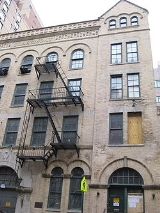
Claremont Riding Academy
Encyclopedia

New York City
New York is the most populous city in the United States and the center of the New York Metropolitan Area, one of the most populous metropolitan areas in the world. New York exerts a significant impact upon global commerce, finance, media, art, fashion, research, technology, education, and...
. It was designed by Frank A. Rooke and built in 1892. It was listed on the National Register of Historic Places
National Register of Historic Places
The National Register of Historic Places is the United States government's official list of districts, sites, buildings, structures, and objects deemed worthy of preservation...
in 1980. and designated a New York City Landmark in 1990. Now closed, Claremont was the oldest continuously operated equestrian stable in New York City.
History
The former Claremont Riding Academy stables (1892) on West 89th Street in the Upper West Side was built to designs by architect Frank Rooke in 1892. It originally began as a livery stable and then later was converted to a riding academy. It was the city's last standing public riding stable.There was an attempt at Urban Renewal in the area in the 1960s that would have destroyed the structure, but it was deflected by preservationists who gave the building borrowed time.
Description
Claremont was a very sophisticated yet homey environment. It was an unusual multistory barn, its floors connected by ramps, housed its horses in individual stalls in the basement and on the second floor. There was an indoor riding ring, but it was quite small and obstructed by posts.Claremont gave riding lessons and did rent horses to experienced riders to ride on the bridle paths in Central Park
Central Park
Central Park is a public park in the center of Manhattan in New York City, United States. The park initially opened in 1857, on of city-owned land. In 1858, Frederick Law Olmsted and Calvert Vaux won a design competition to improve and expand the park with a plan they entitled the Greensward Plan...
. There were jumping, dressage
Dressage
Dressage is a competitive equestrian sport, defined by the International Equestrian Federation as "the highest expression of horse training." Competitions are held at all levels from amateur to the World Equestrian Games...
, group and private lessons. There were about 15-20 instructors.
The location of the stable made for an unusual experience in the equestrian world: riding in heavy traffic. The stable was not in Central Park
Central Park
Central Park is a public park in the center of Manhattan in New York City, United States. The park initially opened in 1857, on of city-owned land. In 1858, Frederick Law Olmsted and Calvert Vaux won a design competition to improve and expand the park with a plan they entitled the Greensward Plan...
itself, but a block and a half away. Getting to the park required riding a horse on Manhattan streets, mixed in with the regular traffic, and crossing Central Park West
Central Park West
Central Park West is an avenue that runs north-south in the New York City borough of Manhattan, in the United States....
.
Final days
The Academy was dependent on the structural condition of the bridle paths in nearby Central Park, as this was the primary designated area for horseback ridingPleasure riding
Pleasure riding is a form of equestrianism that encompasses many forms of recreational riding for personal enjoyment, absent elements of competition. Pleasure riding is called "hacking" in British English, and in parts of the eastern United States and Canada...
in Manhattan. At some point, the city allowed the bridle paths to be used by pedestrians, joggers, bicyclists and others, and discontinued structural maintenance of the paths. With the overuse of the paths in combination with the city's discontinuance of maintenance, riders were no longer able to canter on the pathways, ending one of the pleasures of horseback riding which deterred new ridership. Due to declining patronage and increasing cost from renovations and taxes, Claremont closed forever at 5 p.m. April 29, 2007.
It was rumored that the building will be converted into condominium
Condominium
A condominium, or condo, is the form of housing tenure and other real property where a specified part of a piece of real estate is individually owned while use of and access to common facilities in the piece such as hallways, heating system, elevators, exterior areas is executed under legal rights...
s. According to Joanne Meszoly's article in Equus Magazine's July 2007 issue #358, the fate of the building is unknown.

